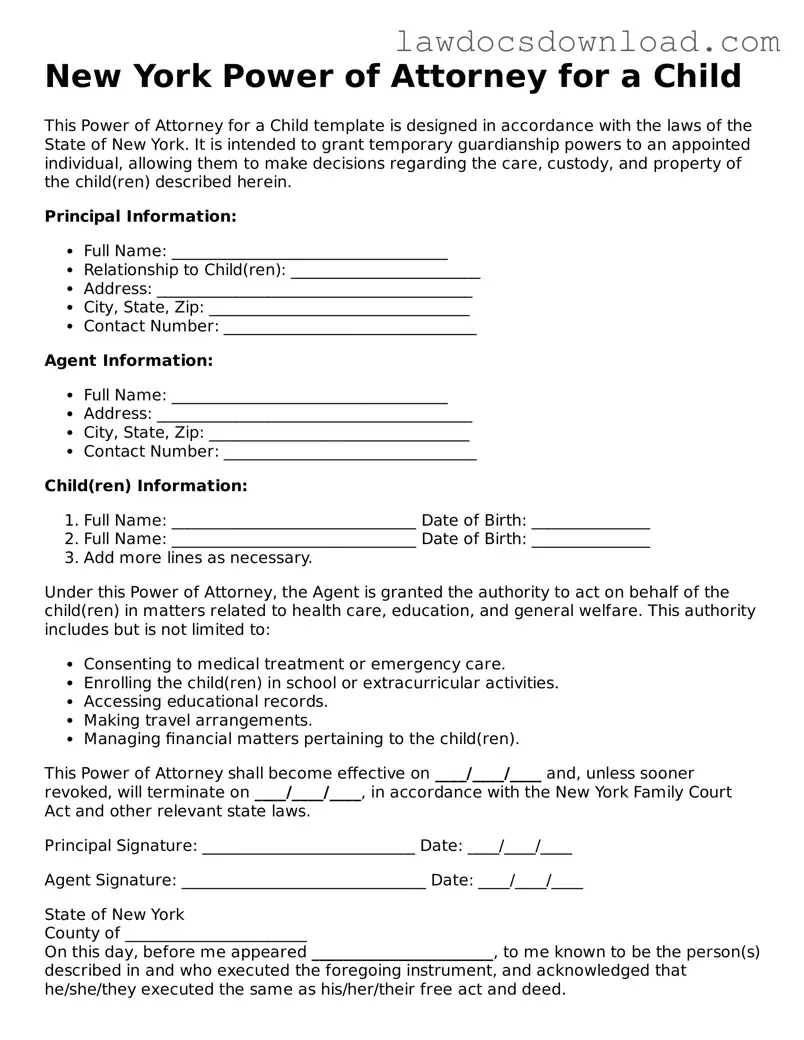In the process of filling out the New York Power of Attorney for a Child form, numerous individuals inadvertently make errors that can significantly affect the document’s legality and effectiveness. One common mistake is the failure to provide complete information about the child, such as their full name, date of birth, and address. This omission can lead to confusion and legal challenges when trying to use the Power of Attorney in various situations, such as medical or educational settings.
Another frequent oversight is not correctly identifying the appointed attorney-in-fact. This role, crucial for the document to serve its intended purpose, requires the full name, address, and contact information of the person being granted authority. Without precise details, enforcing the Power of Attorney’s provisions becomes a complex issue, potentially rendering it ineffective when needed most.
Often, people neglect to specify the scope of the attorney-in-fact’s powers. A Power of Attorney for a Child should clearly outline the decisions and actions that the attorney-in-fact is authorized to undertake on behalf of the child. Whether it's regarding medical care, educational matters, or everyday decisions, a lack of clarity can cause significant roadblocks in carrying out the required duties.
Moreover, the duration for which the Power of Attorney is valid is sometimes left ambiguous. Without a clearly defined period or a specific termination date, disputes may arise over the legitimacy of the attorney-in-fact's actions, especially as circumstances change over time. It's crucial to set a clear expiration date or conditions under which the Power of Attorney will cease to be effective.
The necessity of obtaining proper witnesses and a notarization is another detail that is often overlooked. For a Power of Attorney for a Child to be legally binding in New York, it needs to be signed in the presence of two witnesses and notarized. Skipping these steps can invalidate the document, making it unusable for its intended purpose.
Furthermore, inadequate distribution of the completed document is a critical mistake. Copies of the Power of Attorney should be given to all relevant parties, including the attorney-in-fact, healthcare providers, schools, and any other institutions or individuals that may need to recognize the attorney-in-fact’s authority. Failure to distribute the document appropriately can delay or prevent the attorney-in-fact from acting on the child’s behalf.
Some individuals mistakenly believe that once the document is signed, no further review or updates are necessary. However, as circumstances change, the Power of Attorney for a Child may need to be amended or revoked and then reissued to accurately reflect the current situation. Regularly reviewing and updating the document ensures that it remains valid and effective.
Lastly, there’s a tendency to undertake the completion of such forms without professional advice. Given the legal complexities and the significant consequences of errors in a Power of Attorney for a Child, consulting with a legal professional can preempt mistakes and ensure that the document fully serves its intended purpose while complying with New York state laws.
